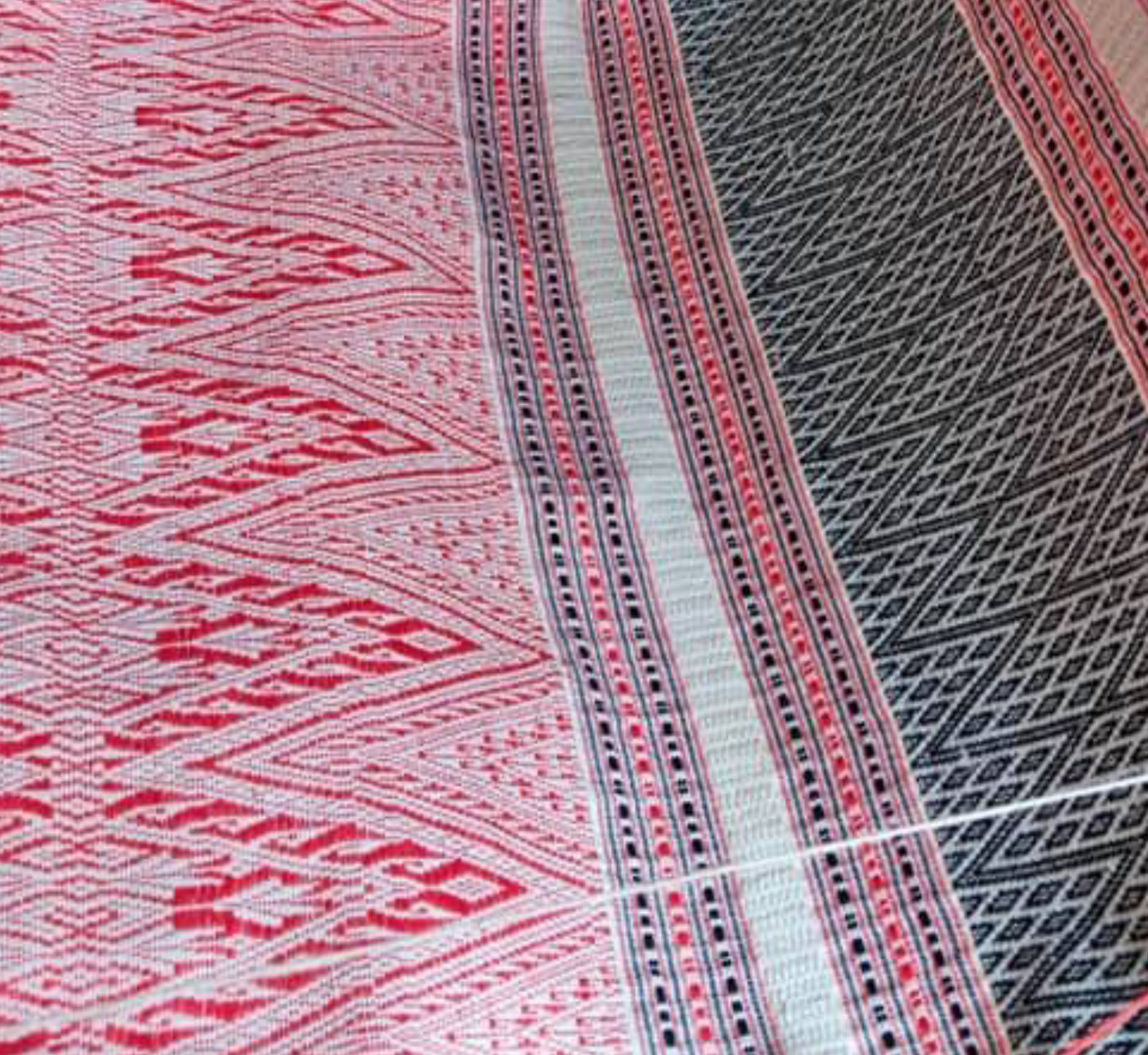Restoration and Development of Pha Law design with The participation process of Ban Mai Sala Phueang community enterprise group Chiang Khan district, Loei province
DOI:
https://doi.org/10.69598/decorativeartsjournal.1.59-96Keywords:
Revival of Pha Law, design development, participatory process, community enterprise groupsAbstract
Abstract
The objectives of this research were 1) to study the rehabilitation of wheel cloth from Ban Mai Sala Phueng Community Enterprise Group. Chiang Khan District, Loei Province, and 2) to study the process of participation in the design development of the Ban Mai Sala Phueng Community Enterprise Group. Chiang Khan District, Loei Province. The target group used in the research were 22 group members. Local scholars, cultural activists, representatives of local government organizations, entrepreneurs, weaving scholars, design scholar. Methods and tools used to collect data include: study of documents Group discussions, meetings, observations and assessments Analyze data with content analysis The results of the study found that
1) Pha Law or underclothes are fabrics for laying mattresses that are woven for use in special occasions such as weddings, hanging for guests who stay overnight at home, woven fabric 180 cm long, 80 cm wide. With Khit weaving technique, 1 piece of cloth has 5 patterns. Originally, every household was woven, nowadays, it has not been woven for more than 80 years. By weaving and using 3 - 4 weavers per 1 weaving, the weaving process will be accomplished quickly When finished, it will be decorated with circumference on all sides with hand-woven cotton with natural dyes.
2) The process of participation in the design and development of Pha Law will be through the concept of participation of group members, consisting of joint thinking, joint planning, joint decision making, joint implementation and evaluation of group members. The details are as follows. (1) Learning the feasibility of reviving and developing designs (2)Pattern analysis and design thinking and development (3)Design through practice (4) Analysis for design development (5) design and development evaluation.
1) Pha Law or underclothes are fabrics for laying mattresses that are woven for use in special occasions such as weddings, hanging for guests who stay overnight at home, woven fabric 180 cm long, 80 cm wide. With Khit weaving technique, 1 piece of cloth has 5 patterns. Originally, every household was woven, nowadays, it has not been woven for more than 80 years. By weaving and using 3 - 4 weavers per 1 weaving, the weaving process will be accomplished quickly When finished, it will be decorated with circumference on all sides with hand-woven cotton with natural dyes.
2) The process of participation in the design and development of Pha Law will be through the concept of participation of group members, consisting of joint thinking, joint planning, joint decision making, joint implementation and evaluation of group members. The details are as follows. (1)Learning the feasibility of reviving and developing designs (2)Pattern analysis and design thinking and development (3)Design through practice (4) Analysis for design development (5) design and development evaluation.
References
กิตติ์ธนัตถ์ ญาณพิสิษฐ์. (2556). ลวดลายผ้าทอร่วมสมัยภายใต “จินตนาการใหม่”. วารสารศิลปกรรมศาสตร์
มหาวิทยาลัยขอนแก่น, 5(2), 155-213.
กัญญา จึงวิมุติพันธ์. (2553). การประยุกต์มิติทางวัฒนธรรมเพื่อการพัฒนาการออกแบบผลิตภัณฑ์ผ้าย้อมครามบ้านคันพะลาน ตำบลนาตาล อำเภอนาตาล จังหวัดอุบลราชธานี. วารสารวิชาการคณะสถาปัตยกรรมศาสตร์ มหาวิทยาลัยขอนแก่น, 9(1), 61-68.
จรัสพิมพ์ วังเย็น. (2554). แนวคิดหลังสมัยการย้อนสู่โลกแห่งภูมิปัญญา. สถาบันวัฒนธรรมและศิลปะมหาวิทยาลัยศรีนครีนทรวิโรฒ, 13(1), 20-23.
ทีปกา โยธารักษ์. (2559). ผ้าเกาะยอ : ทุนทางวัฒนธรรมในยุคโลกาภิวัฒน์ : กรณีศึกษากลุ่มราชวัตถ์แสงส่องหล้าที่ 1 แห่งชุมชนเกาะยอ หมู่ 3 ตำบลเกาะยอ อำเภอเมือง จังหวัดสงขลา. ภาควิชามานุษยวิทยา คณะโบราณคดี มหาวิทยาลัยศิลปากร.
ปิลันลน์ ปุณญประภา, พฤทธิ์ ศุภเศรษฐศิริ, นพดล อินทร์จันทร์ และ กิตติกรณ์ นพอุดมพันธ์. (2561). ปัจจัยที่ทำให้เกิดปัญหาต่อภูมิปัญญาและการสืบทอดผ้าทอไทยพวนบ้านใหม่ จังหวัดนครนายก. วารสารวิชาการนวัตกรรมสื่อสารสังคม, 6(1), 159-168.
ผกามาศ บุตรสาลี, แก้วมณี อุทิรัมย์ และ อุดมพงษ์ เกศศรีพงษ์ศา. (2562). แนวทางการพัฒนาศักยภาพในการสร้างเอกลักษณ์สินค้าเพื่อเสริมสร้างความเข้มแข็งอย่างยั่งยืนกลุ่มทอผ้าย้อมครามบ้านโพนก่อ ตำบลท่าก้อน
อำเภออากาศอำนวย จังหวัดสกลนคร. วารสารวิจัยและพัฒนา มหาวิทยาลัยราชภัฏบุรีรัมย์, 14(2), 46-56.
พจน์ธรรม เจริญวิทย์ และ อำไพ แสงจันทร์ไทย. (2561). การออกแบบและการพัฒนาผลิตภัณฑ์กระเป๋าสำหรับสุภาพสตรีจากผ้าผ้าฝ้ายย้อมสีธรรมชาติ กลุ่มทอผ้าย้อมสีธรรมชาติไหมแก้วพัฒนา จังหวัดกำแพงเพชร. สักทอง, 24(2), 119-134.
พรชัย ปานทุ่ง. (2562). การพัฒนาผลิตภัณฑ์ผ้าทอแบบมีส่วนร่วมของชุมชนบ้านภูทอง จังหวัดสุโขทัย. วารสารวิจัยเพื่อการพัฒนาเชิงพื้นที่, 11(4), 331-345.
สคราญนิตย์ เล็กสุทธิ์. (2561). การสืบสานภูมิปัญญาท้องถิ่นผ้าฝ้ายทอมือที่สอดคล้องกับหลักพุทธธรรมของกลุ่มผ้าฝ้ายทอมือ บ้านหนองเงือก ตำบลแม่แรง อำเภอป่าซาง จังหวัดลำพูน. วารสารวิชาการมหาวิทยาลัยธนบุรี, 12(29), 135-146.
สุจิตตรา หงส์ยนต์ และ พิกุล สายดวง. (2560). การมีส่วนร่วมในการสืบสานศิลปะการทอผ้าไหมสู่การตระหนักและสืบทอดทางวัฒนธรรมกรณีศึกษาชุมชนในจังหวัดอุบลราชธานี. วารสารมนุษยศาสตรและสังคมศาสตร์ มหาวิทยาลัยราชภัฏอุบลราชธานี, 8(4), 223-234.
ศิริพร เวียงเงิน, อริสรา ศรีมาลา และ ตุลาภรณ์ แสนปรน. (2562). ผ้าทอไทลื้อ : ภูมิปัญญาบนลายผ้าของชุมชนบ้านป่าปี้ ตำบลบ้านธิ อำเภอบ้านธิ จังหวัดลำพูน. วารสาร มจร.นครน่านปริทรรศน์, 3(2), 95 -103.
ศักดิ์ชาย สิกขา, ประทับใจ สิกขา และ วีระ พันธ์สุวรรณ. (2555). การศึกษาอัตลักษณ์ท้องถิ่นเพื่อสร้างสรรค์ลายผ้าแถบลุ่มน้ำโขง : กรณีศึกษาบ้านกุ่ม ตำบลห้วยไผ่ อำเภอโขงเจียม จังหวัดอุบลราชธานี. สำนักงานศิลปวัฒนธรรมร่วมสมัย กระทรวงวัฒนธรรม.
อุทิศ ทาหอม, จริยา ดวดไธสง และ อันธิกา คงประโคน. (2561). แนวทางการบริการจัดการกลุ่มทอผ้าไหมบ้านหนองไทรงาม ตำบลชุมเห็ด อำเภอเมือง จังหวัดบุรีรัมย์. วารสารพัฒนศาสตร์, 1(1), 98-129.

Downloads
Published
How to Cite
Issue
Section
Categories
License
Copyright (c) 2022 DEC Journal

This work is licensed under a Creative Commons Attribution-NonCommercial-NoDerivatives 4.0 International License.
Published by Academic Affairs Division, Faculty of Decorative Arts, Silpakorn University. The copyright of the article belongs to the article owner. Published articles represent the views of the authors. The editorial board does not necessarily agree with and is not responsible for the content of such articles.


